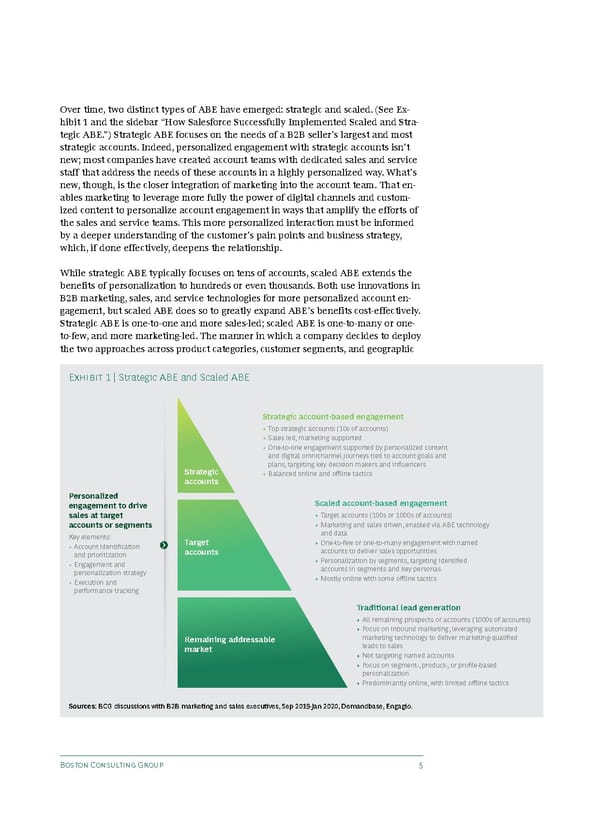Over time, two distinct types of ABE have emerged: strategic and scaled. (See Ex- hibit 1 and the sidebar “How Salesforce Successfully Implemented Scaled and Stra- tegic ABE.”) Strategic ABE focuses on the needs of a B2B seller’s largest and most strategic accounts. Indeed, personalized engagement with strategic accounts isn’t new; most companies have created account teams with dedicated sales and service staff that address the needs of these accounts in a highly personalized way. What’s new, though, is the closer integration of marketing into the account team. That en- ables marketing to leverage more fully the power of digital channels and custom- ized content to personalize account engagement in ways that amplify the efforts of the sales and service teams. This more personalized interaction must be informed by a deeper understanding of the customer’s pain points and business strategy, which, if done effectively, deepens the relationship. While strategic ABE typically focuses on tens of accounts, scaled ABE extends the benefits of personalization to hundreds or even thousands. Both use innovations in B2B marketing, sales, and service technologies for more personalized account en- gagement, but scaled ABE does so to greatly expand ABE’s benefits cost-effectively. Strategic ABE is one-to-one and more sales-led; scaled ABE is one-to-many or one- to-few, and more marketing-led. The manner in which a company decides to deploy the two approaches across product categories, customer segments, and geographic Exhibit 1 | Strategic ABE and Scaled ABE Strategic account-based engagement • Top strategic accounts (10s of accounts) • Sales led, marketing supported • One-to-one engagement supported by personalized content and digital omnichannel journeys tied to account goals and Strategic plans, targeting key decision makers and influencers • Balanced online and offline tactics accounts Personalized Scaled account-based engagement engagement to drive sales at target • Target accounts (100s or 1000s of accounts) accounts or segments • Marketing and sales driven, enabled via ABE technology Key elements: and data • Account identification Target • One-to-few or one-to-many engagement with named and prioritization accounts accounts to deliver sales opportunities • Engagement and • Personalization by segments, targeting identified personalization strategy accounts in segments and key personas • Execution and • Mostly online with some offline tactics performance tracking Traditional lead generation • All remaining prospects or accounts (1000s of accounts) • Focus on inbound marketing, leveraging automated Remaining addressable marketing technology to deliver marketing-qualified market leads to sales • Not targeting named accounts • Focus on segment-, product-, or profile-based personalization • Predominantly online, with limited offline tactics Sources: BCG discussions with B2B marketing and sales executives, Sep 2019-Jan 2020, Demandbase, Engagio. Boston Consulting Group 5
 BCG moving beyond ABM to account based engagement Page 6 Page 8
BCG moving beyond ABM to account based engagement Page 6 Page 8